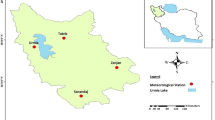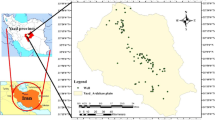Abstract
Drought is a phenomenon that occurs slowly, affecting surface water and groundwater resources, which can reduce the water supply, worsen water quality and deteriorate agricultural products, and affect economic and political activities. Urmia Lake basin has been exposed to severe water stress in recent years. Therefore, in this study, drought monitoring in Tabriz synoptic station as one of the most important stations in Urmia Lake basin in the short-term, mid-term, and long-term steps of 53 years period was investigated using the Standard Precipitation and Evapotranspiration Index (SPEI). Then, the prediction of the drought was investigated using a hybrid model of the genetic algorithm (GA) and autoregressive integrated moving average model (ARIMA) approaches. The results showed that there were three long periods of drought related to 1961–1963, 1986–1992, and 1997–2009 during the statistical period. In the prediction section, the results showed that based on the Brock-Dechert-Scheinkman (BDS) test, in all SPEI time scales, the time series has predictability. Also, the prediction accuracy of the GA-ARIMA model has a direct correlation with the SPEI time scale. So that in the test section, the determination coefficient in the 1-month time scale (SPEI1) has increased from 0.34 to 0.93 in the 48-month time scale (SPEI48).








Similar content being viewed by others
References
Abbasi A, Khalili K, Behmanesh J, Shirzad A (2019) Drought monitoring and prediction using SPEI index and gene expression programming model in the west of Urmia Lake. Theor Appl Climatol 138(1):553–567
Abramowitz M, Stegun IA (1972) Handbook of mathematical functions: with formulas, graphs, and mathematical tables (Vol. 55, p. 319). National bureau of standards, Washington, DC
Allen, R. G., Pereira, L. S., Raes, D., & Smith, M., 1998. Crop evapotranspiration-guidelines for computing crop water requirements-FAO Irrigation and drainage paper 56. FAO, Rome, 300(9), D05109.
Bazrafshan J, Khalili A (2009) Evaluation of drought duration risk using annual secular precipitation data in ancient stations of Iran. Iranian J Geophys 2(2):13–23
Box, G. E., & Jenkins, G. M,. 1976. Time series analysis: forecasting and control, revised ed: Holden-Day.
Brock WA, Scheinkman JA, Dechert WD, LeBaron B (1996) A test for independence based on the correlation dimension. Econ Rev 15(3):197–235
Da Silva, V. d. P. R. (2004) On climate variability in Northeast of Brazil. J Arid Environ 58(4):575–596
Durdu ÖF (2010) Application of linear stochastic models for drought forecasting in the Büyük Menderes river basin, western Turkey. Stoch Env Res Risk A 24(8):1145–1162
Ervural BC, Beyca OF, Zaim S (2016) Model estimation of arma using genetic algorithms: a case study of forecasting natural gas consumption. Procedia Soc Behav Sci 235:537–545
Fathabadi A, Gholami H, Salajeghe A, Azanivand H, Khosravi H (2009) Drought forecasting using neural network and stochastic models. Adv Nat Appl Sci 3(2):137–146
Holland JH (1962) Outline for a logical theory of adaptive systems. J ACM (JACM) 9(3):297–314
Hosking JR (2009) L-moments. Statistics Reference Online, Wiley StatsRef
Kempes C, Myers O, Breshears D, Ebersole J (2008) Comparing response of Pinus edulis tree-ring growth to five alternate moisture indices using historic meteorological data. J Arid Environ 72(4):350–357
Khalili K, Nazeri Tahrudi M, Abbaszadeh Afshar M, Nazeri Tahrudi Z (2014) Modeling monthly mean air temperature using SAMS2007 (case study: Urmia synoptic station). J Mid East Appl Sci Technol (JMEAST) 15:578–583
Labudova, L., Schefczyk, L., & Heinemann, G., 2014. The comparison of the SPI and the SPEI using COSMO model data in two selected Slovakian river basins. Paper presented at the EGU General Assembly Conference Abstracts.
Miller, J. F., & Thomson, P., 2000. Cartesian genetic programming. Paper presented at the European Conference on Genetic Programming.
Mirabbasi R, Anagnostou EN, Fakheri-Fard A, Dinpashoh Y, Eslamian S (2013) Analysis of meteorological drought in northwest Iran using the Joint Deficit Index. J Hydrol 492:35–48
Mishra A, Desai V (2005) Drought forecasting using stochastic models. Stoch Env Res Risk A 19(5):326–339
Mishra A, Desai V (2006) Drought forecasting using feed-forward recursive neural network. Ecol Model 198(1-2):127–138
Mishra A, Desai V, Singh V (2007) Drought forecasting using a hybrid stochastic and neural network model. J Hydrol Eng 12(6):626–638
Potop V, Možný M (2011) The application a new drought index–standardized precipitation evapotranspiration index in the Czech Republic. Mikroklima a mezoklima krajinných structur a antropogenních prostředí 2:2–14
Raziei T, Daneshkar Arasteh P, Akhtari R, Saghafian B (2007) Investigation of meteorological droughts in the Sistan and Balouchestan province, using the standardized precipitation index and Markov chain model. Iran-Water Resour Res 3(1):25–35
Salas JD (1993) Analysis and modelling of hydrological time series. Handbook Hydrol 19
Sharifan H, Ghahraman B (2007) Evaluation of rainfall forecasting in Golestan Province using time series. Agric Sci Nat Resour 14(3):196–209
Sivanandam, S., & Deepa, S., 2007. Introduction to genetic algorithms: Springer Science & Business Media.
Tajbakhsh S, Eisakhani N, FAZL KA (2015) Assessment of meteorological drought in Iran using standardized precipitation and evapotranspiration index (SPEI). Earth Space Physics 41(2):313–321
Thornthwaite CW (1948) An approach toward a rational classification of climate. Geogr Rev 38(1):55–94
Tornros T, Menzel L (2014) Addressing drought conditions under current and future climates in the Jordan River region. Hydrol Earth Syst Sci 18(1):305–318
Toufani P, Mosaedi A, FAKHERI FA (2011) Prediction of precipitation applying wavelet network model (case study: Zarringol station, Golestan Province, Iran). Water and Soil (Agric Sci Technol) 25(5):1217–1226
Vicente-Serrano SM, Beguería S, López-Moreno JI (2010) A multiscalar drought index sensitive to global warming: the standardized precipitation evapotranspiration index. J Clim 23(7):1696–1718
Vicente-Serrano SM, López-Moreno JI, Drumond A, Gimeno L, Nieto R, Morán-Tejeda E, Zabalza J (2011) Effects of warming processes on droughts and water resources in the NW Iberian Peninsula (1930− 2006). Clim Res 48(2/3):203–212
Whipple W (1966) Regional drought frequency analysis. J Irrig Drain Div 92(2):11–32
Wu B, Chang C-L (2002) Using genetic algorithms to parameters (d, r) estimation for threshold autoregressive models. Comput Stat Data Anal 38(3):315–330
Zareabyaneh H, Ghobaeisoogh M, Mosaedi A (2016) Drought monitoring based on Standardized Precipitation Evapotranspiration Index (SPEI) under the effect of climate change. Water and Soil (Agricultural Sciences and Technology) 29(2):374–392
Author information
Authors and Affiliations
Corresponding author
Ethics declarations
Conflict of interest
The authors declare that they have no competing interests.
Additional information
Responsible Editor: Zhihua Zhang
Rights and permissions
About this article
Cite this article
Abbasi, A., Khalili, K., Behmanesh, J. et al. Estimation of ARIMA model parameters for drought prediction using the genetic algorithm. Arab J Geosci 14, 841 (2021). https://doi.org/10.1007/s12517-021-07140-0
Received:
Accepted:
Published:
DOI: https://doi.org/10.1007/s12517-021-07140-0




